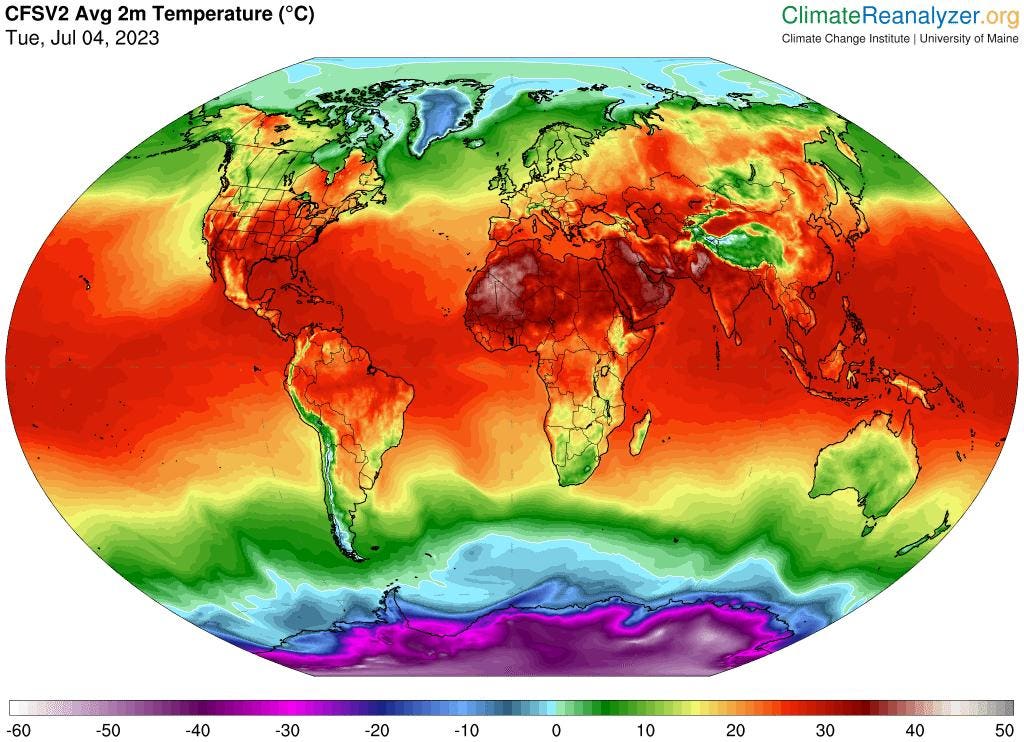I vowed not to write a lot of articles about temperature records because in an era of climate warming, it will be like playing “whack-a-mole.” We have entered new territory so “warmest this” or “hottest that” will be quite common headlines going forward. However, July 4th grabbed my attention and not because of fireworks. The planet may have just experienced its hottest day on record. Here’s the “so what?” of it all.
According to daily near-surface air temperature data from NOAA’s National Center for Environmental Prediction (NCEP ), the mean global temperature on July 4th, 2023 may have exceeded the previous mark for “hottest day” since recordkeeping began. It is important to recognize that I said “since recordkeeping began.” I fully anticipate that some people out there crying in the “social media wilderness” will nitpick headlines that say “ever.” Over the coming weeks, scientists will work to confirm whether the record stands.
Using the NOAA Climate Forecast System (CFS) version 2 and CFS Reanalysis, a numerical climate/weather modeling system that takes in an array of Earth system observations, the map above was made with the University of Maine Climate Reanalyzer tool. NOAA-NCEP data revealed that the average global temperature climbed to 62.92 degrees Fahrenheit (17.18 degrees Celsius). Before you say, “wait Dr. Shepherd, 63 degrees is not that hot,” remember that this is average temperature across the entire globe. Half of it is experiencing winter right now.
Writing in The Washington Post, Leo Sands said, “The last time the record was broken was on Monday, when the temperature was 62.62 degrees Fahrenheit, according to the same data.” Prior to this two-day span, the record was likely recorded on August 14th, 2016. In the tweet above, University of California climate expert Robert Rohde cautioned that even hotter days could lie ahead.
Many scientists, including me, warned that 2023 could challenge previous years as Earth’s warmest year on record. The year 2023 is a triple-whammy of climate change, the onset of El Niño, and natural warming variability associated with Summer in the northern hemisphere. The year 2016 holds the dubious distinction of being the warmest year on record and like this year, an El Niño was present.
The irony is that climate scientists often have to fend off cliche, ill-posed statements that “climate changes naturally.” Of course it does. I promise you that climate scientists did not skip those classes. Our hottest years exemplify that natural variability (El Niño, summer) coupled with anthropogenic-driven climate change supercharges Earth’s heat system. It is “and” not “either/or.” Unfortunately, none of this is unexpected. A recent World Meteorological Organization (WMO) report warned of a 66% chance that annual near surface temperatures averaged for the globe could exceed the 1.5°C targets during the 2023 to 2027 time frame.
By the way, the extraordinary warming is not exclusively evident in the atmosphere. The oceans are soaking up excess heat in a big way too. A tweet by Professor Katharine Hayhoe sums it up this way, “Oh, and I should mention: how much of that heat has been going into the atmosphere? Just ONE PERCENT. 89% is going into the ocean, the rest into land and the cryosphere.” Hayhoe, a renowned climate expert and Chief Scientist at The Nature Conservancy, told The Guardian current abnormal warm temperatures in the north Atlantic are due to years of “loading” the system with three hundred eighty Zettajoules of excess heat. By the way, 1 Zettajoule is 1021 joules (1 ZJ = 1 000 000 000 000 000 000 000 J).
While these heat statistics are alarming in themselves, I am equally concerned about the implications of excessive heat in the system on tropical cyclones, sea ice, sea level, public health, agricultural productive, water stress, energy production, crisis acceleration, and more. For this reason, I hope that we can treat these “new normal” heat anomalies like threats not opportunities to frolic in water fountains.
Read the full article here





